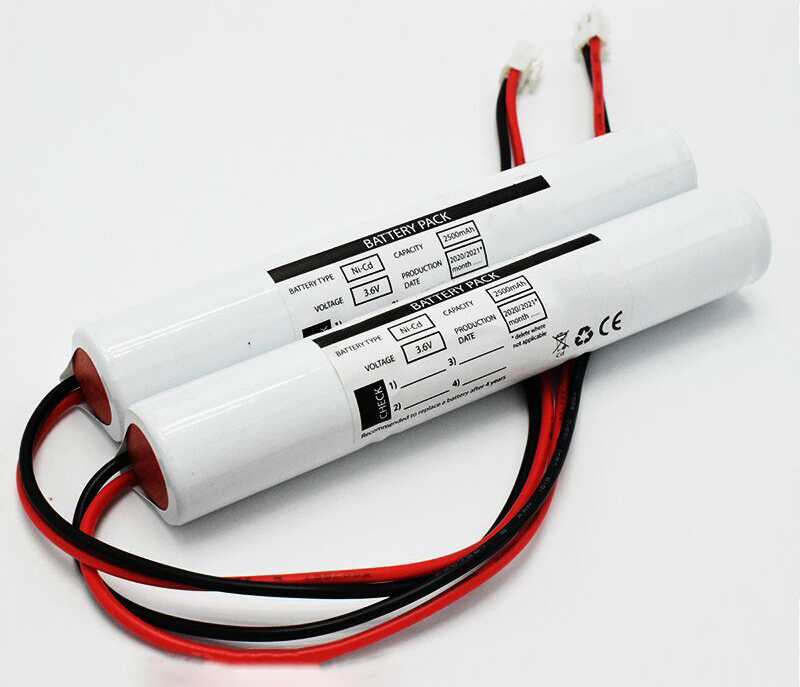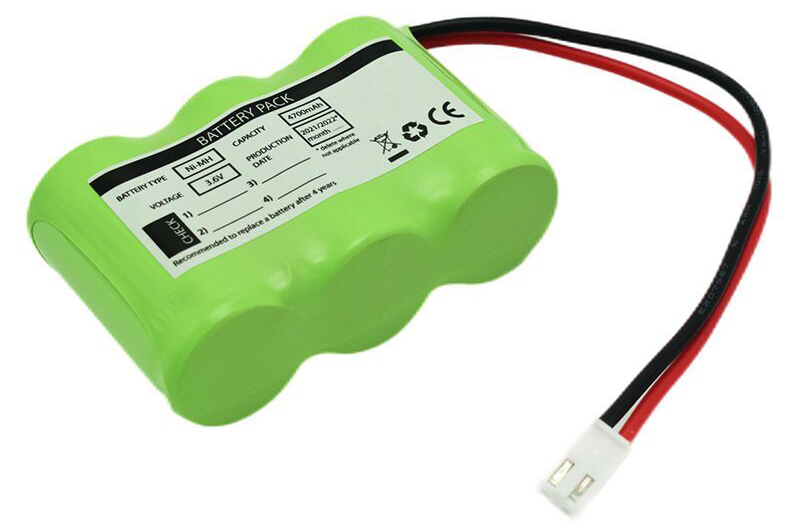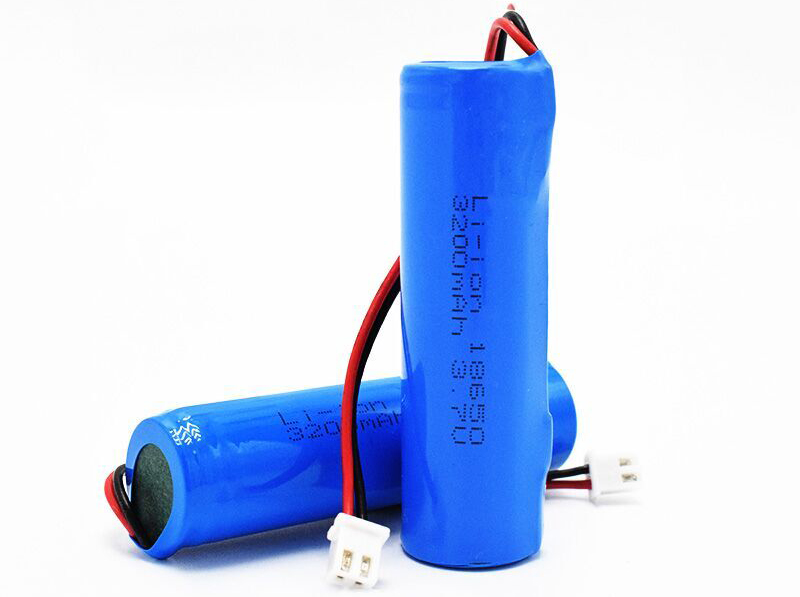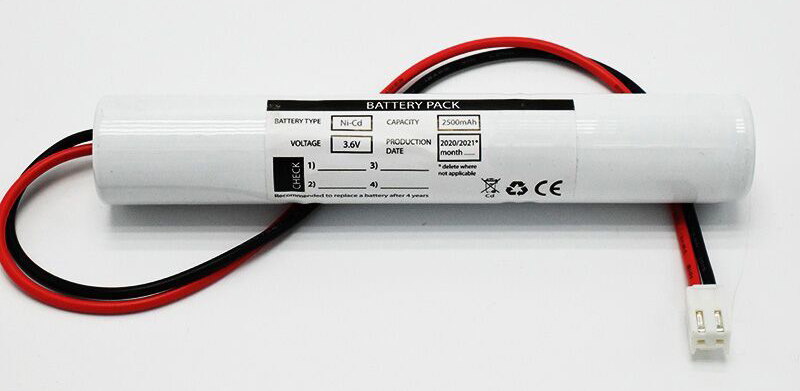These were commonly used till recently in self-contained emergency lighting fixtures, such as a twinspot, and are still widely used in central battery systems. Outside these specific applications, lead acid batteries are now rarely used in emergency lighting.
Cadmium is highly toxic and is one of only 6 substances banned by the EU’s RoHS Directive. However, an exemption is in place for batteries in emergency lighting because till recently there have been few suitable alternatives. NiCd batteries are widely used in stand-alone emergency lighting fixtures and in emergency conversion kits.

These batteries are widely used in place of NiCd in emergency conversion kits where they have some (slight) advantages in some applications.

There are many types of lithium battery and they are becoming more widely used for emergency lighting. They have many advantages over lead acid, NiCd and NiMH so their use is increasing rapidly.

1. Nickel Cadmium (NiCd) Batteries are currently one of the most reliable and high safety chemistries in the market. NiCd batteries give more watt-hours of operation per shift as compared to other battery chemistries. They are ideal for a user who needs high-performance battery with high safety and long lifetime and for usage under extreme conditions of cold and heat (-20C to +50C).
2. Nickel Metal Hydride (NiMH) Batteries offer shorter operation life with 500 cycles as compared to Nicd. These batteries provide 2 times more capacity than NiCd under same size, and operate as efficiently as Nicd in extreme temperatures. In addition, it is environmental friendly battery.
3. Lithium-Ion (Li Ion) Batteries power to weight ratio exceeds that of NiMH for a lighter, smaller power supply. These batteries tend to be the industry’s most economical chemistry, and they offer good performance in extreme temperature.
Lithium iron phosphate (LiFePO4, or LFP) are very well suited for use in emergency lighting. When compared with alternatives such as nickel cadmium (NiCd) and nickel metal hydride (NiMH), lithium iron phosphate (LFP) batteries have several advantages:
● Self discharge. All rechargeable batteries lose charge over time, but with LFP the rate is only 3-5% per month. NiCd can lose 15% in the first 24 hours, falling to 10-20% per month (depending on temperature) after that. The result of this is that the charger in an emergency fitting with NiCd or NiMH batteries is working almost continually, whereas the charger in an LFP circuit is working at low current in short and infrequent bursts.
● Charge efficiency. Energy is lost in the form of heat during the charging process of any battery. With LFP the charge efficiency is very high, about 95%. With NiCd the charge efficiency is also very high, but only in the earlier stages of charging. Once the battery reaches 70% capacity heat starts to be generated and the charging efficiency falls to c 85%. This is significant because in normal use a NiCd battery in an emergency light fitting is being continually trickle-charged to keep it at near 100% capacity.

● LFP batteries have little memory effect so their performance remains almost constant till they reach end of life, usually defined as 70% of rated capacity. Typically, an LFP battery will have a life of 8-10 years.
● The performance (power storage) of NiCd and NiMH declines rapidly with every charge/discharge cycle, so they typically need to be changed after 3 or 4 years. The routine testing of emergency lighting required by BS 5266 contributes to shortening the life of NiCd batteries. It is also common for NiCd batteries in new-build projects to fail in their first year of life if they have been fully installed in the construction phase when the mains power would normally be switched off completely overnight. The resulting nightly discharge and daily re-charge degrades the NiCd batteries to the point that they can be due for replacement withing the first year of occupation.
● High temperatures. LFP is unharmed by ambient temperatures up to 55°C, whereas NiCd is limited to 50°C and NiMH is limited to 50°C.
● Low temperatures. Neither LFP, NiCd or NiMH are rated for use below 0°C.
● Cadmium is highly toxic. Cadmium is highly toxic to almost all animals and many plants. It is also very persistent in the environment, being not easily combined with other elements that would render it harmless. NiCd batteries therefore have to be recycled with great care. LFP batteries must also be recycled, but the materials used are inherently less harmful than those used in NiCd and NiMH batteries.
● Lithium has a long future ahead. Lithium iron phosphate in particular is favoured for its safety, economy and efficiency and is being increasingly used in many applications, such as vehicles, in addition to emergency lighting.
Godson Technology Co., Ltd. is a globally trusted supplier and manufacturer of emergency lighting battery, emergency lighting products. Any questions about them, feel free to contact us.

 Ni-MH Battery C4700mAh 3.6V
Ni-MH Battery C4700mAh 3.6V Nickel Cadmium Nicd Battery Pack SC1800mAh 3.6V
Nickel Cadmium Nicd Battery Pack SC1800mAh 3.6V Ni-Cd Battery Pack D4000mAh 3.6V
Ni-Cd Battery Pack D4000mAh 3.6V Ni-Cd Battery Pack C2500mAh 3.6V
Ni-Cd Battery Pack C2500mAh 3.6V NICAD Battery Pack AA900mAh 3.6V
NICAD Battery Pack AA900mAh 3.6V LiFePO4 IFR18650 1600mAh 3.2V
LiFePO4 IFR18650 1600mAh 3.2V LiFePO4 IFR18650 1600mAh 6.4V
LiFePO4 IFR18650 1600mAh 6.4V Ni-MH Battery C4000mAh 3.6V
Ni-MH Battery C4000mAh 3.6V E-bike Battery 48V 10Ah JL-1
E-bike Battery 48V 10Ah JL-1 E-bike battery 48V 10Ah Qing Tian
E-bike battery 48V 10Ah Qing Tian